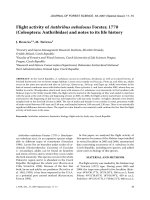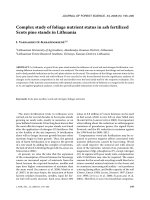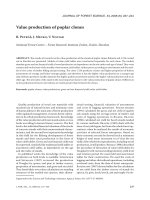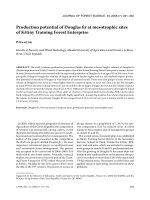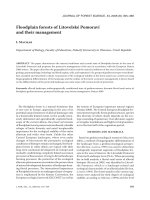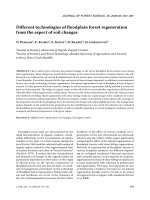Báo cáo lâm nghiệp: "ree nutrition of Norway spruce as modified by liming and experimental acidification at the Höglwald site, Germany, from 1982 to 2004" pdf
Bạn đang xem bản rút gọn của tài liệu. Xem và tải ngay bản đầy đủ của tài liệu tại đây (501.99 KB, 9 trang )
Ann. For. Sci. 63 (2006) 861–869 861
c
INRA, EDP Sciences, 2006
DOI: 10.1051/forest:2006069
Original article
Tree nutrition of Norway spruce as modified by liming
and experimental acidification at the Höglwald site, Germany,
from 1982 to 2004
Christian H
*
, Wendelin W
,AxelG
¨
Fachgebiet für Waldernährung und Wasserhaushalt, Department für Ökologie, WZW, TU München, Am Hochanger 13, 85354 Freising, Germany
(Received 31 October 2005; accepted 23 March 2006)
Abstract – From 1982 to 2004 the elemental concentrations of current, current+1, and current+2 year old needles of a mature spruce stand were
investigated at the N-saturated, acidified, but healthy Höglwald site. The control was compared with a liming, experimental acid irrigation, acid irrigation
+ liming, normal irrigation, and normal irrigation + liming treatment. Liming was performed in 1984, and irrigation from 1984–1990. High year to year
variations were found for most of the elements in all treatments, especially for K (“deficient” to “high”). Despite the N saturation of the ecosystem,
needles showed no N-overfeeding of the trees. N, Mg, K, Fe concentrations showed no clear treatment effects. Twenty years after liming a lowered P
availability is indicated, which was more pronounced in older needles. Ca concentrations increased after liming, while Al decreased. The elemental
concentrations of the acid irrigated treatment did not differ significantly from the normal irrigated or control treatment.
liming / long term study / soil acidification / spruce / tree nutrition
Résumé – Modifications de la nutrition forestière par acidification expérimentale et chaulage dans le site du Höglwald (Allemagne) entre 1982
et 2004. Les concentrations en éléments minéraux des aiguilles de l’année, et celles âgées d’un an et de deux ans ont été mesurées entre 1982 et
2004 dans un peuplement d’épicéa adulte, saturé en azote et acidifié, mais sain, du site de Höglwald. Ce témoin a été comparé avec les traitements
suivants : chaulage, irrigation acide expérimentale, irrigation acide + chaulage, irrigation normale, irrigation normale + chaulage. de fortes variations
interannuelles ont été observées pour tous les éléments et tous les traitements, particulièrement pour K (teneurs déficientes à élevées). Malgré la
saturation en azote de l’écosystème, les aiguilles n’indiquaient pas d’excès de nutrition azotée. Les concentrations en N, Mg, K et Fe n’ont pas été
affectées par les traitements. Vingt années après le chaulage, une plus faible disponibilité en P est indiquée, spécialement par les aiguilles agées. Les
concentrations en Ca des aiguilles augmentent après chaulage, et celles en al baissent. Les concentrations mesurées dans le traitement d’irrigation acide
ne diffèrent pas de celle des traitements irrigation normale ou du témoin.
chaulage / étude à long terme / acidification des sols / épicéa / nutrition forestière
1. INTRODUCTION
Forest liming has been practised increasingly in Central and
Northern Europe since the 1980s as a countermeasure against
the destabilisation of forests and the decrease in water qual-
ity due to acid rain and soil acidification [39, 40]. The ex-
pected positive effects of forest liming are the deacidification
of soil and seepage water, and the increase in Ca and Mg sup-
ply of the soil [2], which may have been decreased by vari-
ous processes of soil acidification [4]. However, negative ef-
fects have also occurred: emission of CO
2
due to the loss of
organic matter [22, 32], NO
−
3
leaching [25], and reduced tree
growth [31, 36]. Therefore, forest liming is still controversial
in Central and Northern Europe [19, 24,27,31, 32,36, 41] and
the various foci and interpretations of the findings of the acidi-
fication/liming problems have resulted in very diverse policies,
especially in the German states [19]. However, there is still lit-
tle information about the long-term effects of liming on the
* Corresponding author:
nutrient concentrations in the leaves, although this criterion is
widely used for evaluation of the nutrient status, soil nutrient
availability, and as an indicator of forest health [13]. In gen-
eral, long-term studies on the nutrient status are rare [38]. A
broader assessment of forest nutrition of forests in Europe was
not started until the Level II programme in 1994 [29]. In the
1980s, a forest liming and acidification experiment was estab-
lished at the Höglwald site [26], Southern Germany, and tree
nutrition was monitored until 2004. In this paper, we will show
the time trends of nutrient concentrations in the needles.
2. MATERIALS AND METHODS
2.1. Site and stand description
The Höglwald is a long-term ecological monitoring and experi-
mentation site [19,26]. The small forest district (370 ha) is situated on
a flat hilltop at an altitude of 540 m above sea level, about 70 km north
of the Alps and 50 km west of Munich at 11
◦
06’ E and 48
◦
17’ N.
Article published by EDP Sciences and available at or />862 C. Huber et al.
The soil is a Parabrown Earth strongly acidified in the topsoil. The
mineral soil is covered by an organic layer of 6 to 8 cm (moder). In
the organic layer the base saturation is relatively high (40 to 80%),
but the pH values are extremely low with a minimum in the Oh hori-
zon of 2.75 (KCl). The base saturation in the A horizon (0–40 cm)
is only 5–10%, and the Al saturation is high (80–90%). The pH val-
ues of 4.0 (KCl) indicate the aluminium buffer range. In the B hori-
zon (40–130 cm), the base saturation increases with depth as well as
pH values. There is a great subsoil reservoir of exchangeable Ca
2+
and Mg
2+
accessible to the deep reaching vertical root system, while
the K
+
supply of the CEC is relatively short [26]. The C/N ratio in
the forest floor varies between 23 and 27. The productivity of the
stand is not limited by the availability of N – the site is N-saturated:
throughfall input is about 30 kg N ha
−1
yr
−1
[34], adsorption of am-
monia in the forest floor seems to be a significant input [17, 18]; the
excess N causes high NO
−
3
leaching [20] and volatilisation of trace
gases [6]. The stands are fully stocked, vigorously growing mature
Norway spruce plantations (Picea abies (L.) Karst). Before the ex-
perimental treatment was started (1983), the spruce stand had the
following dendrometrical characteristics: 76 years old, a density of
603 trees per ha, a basal area of 70.9 m
2
ha
−1
, a growing stock of
1124 m
3
ha
−1
, a mean breast height diameter of 38.7 cm, the mean
height was 33.8 m, and the dominant height was 35.9 m [26]. More
information about the dendrometrical characteristics of the treatments
is given by Huber et al. [19].
2.2. Experimental treatments
The treatments are part of a larger experimental set-up [26]. In
an area with very uniform stand and site conditions, the following
treatments were made:
A 1 control;
B 1 acid irrigation;
C 1 normal irrigation;
A 2 liming;
B 2 liming with acid irrigation;
C 2 liming with normal irrigation.
The area of each experimental treatment is 2500 m
2
, separated
into centre (900–1000 m
2
) and periphery. A plan of the Höglwald
experiments is given in Kreutzer and Weiss [26]. The stands were
limed manually in April 1984 with sieves using 4 t ha
−1
of fine
(90% < 0.1 mm) ground dolomitic limestone [21] resulting in inputs
of 22 kmol ha
−1
Ca and 20 kmol ha
−1
Mg. Irrigation was performed
from Spring 1984 to Autumn 1990 with a sprinkler system. Each year
between May and November, 15 to 18 irrigation events were carried
out. The annual amount of irrigation was 170–180 mm, which in-
creased the natural throughfall input between May and November
by about 50%. Tap water was deionised and adjusted to rain water
conductivity (10–20 µScm
−1
) through the addition of Ca(NO
3
)
2
and
MgSO
4
. For acid irrigation, a pH of approx. 2.6 was obtained through
the addition of H
2
SO
4
.
2.3. Sampling and chemical analysis
Needles were collected in the dormant season from the upper third
of the crown from randomly selected dominant trees by helicopter or
tree climbers and sampled separately for the different treatments and
needle age classes: current needles (C), current plus one year old nee-
dles (C+1), and current plus two year old needles (C+2). After sam-
pling, needles were dried at 65
◦
C. N was analysed with CHN (Leco).
P, K, Mg, Ca, Al, Mn, and Fe were measured with ICP-OES (Perkin-
Elmer) after dissolution with HNO
3
(65%) for 12 h in pressure bombs
(165
◦
C). Finally, dry mass of 100-needle samples were determined.
In 1990, 1991, 1997, and 2004 each tree and needle age class was
analysed separately (N = 10), while in the other years a mixed sam-
ple was made for each needle age class and treatment from 6 to 10
trees from each treatment.
2.4. Statistical methods
Treatment effects for individually analysed needles were evaluated
with a one-way ANOVA using the statistical package SPSS 11.01 for
Windows (SPSS Inc.). Tukey test (equal variances), and Thamhane’s
T2 (unequal variances according to Levene statistics) were used as
post-hoc tests. A critical probability level of 0.05 was used to indicate
significant differences.
3. RESULTS
N was generally higher in the current (C) (mean for all treat-
ments: 15.0 mg g
−1
) than in the C+1 (13.8 mg g
−1
)andC+2
(12.9 mg g
−1
) needles (Fig. 1). According to the classification
given in Table I, the status of the current needles represents a
broad spectrum, which stretches from low to high, while aver-
age and high values dominate. No statistically significant dif-
ferences (Tab. II) could be observed for any of the treatments.
High year to year variations were observed for P (Fig. 2),
especially in the C needles, varying from very low to high
levels. Generally, the C needles had higher P concentrations
(average: 1.6 mg g
−1
) than the C+1(1.2mgg
−1
)andC+2
(1.1 mg g
−1
) needles. Statistically significant effects were only
found between some of the treatments in 2004 (see Tab. II).
Figure 2 indicates a higher susceptibility for lower P concen-
trations on the limed treatments for the C+2andC+1, but not
for the C needles.
K showed very high variation between years (Fig. 3). The
level varied from the categories “very low” to “high”. C
needles normally had higher levels (4.3 mg g
−1
)thanC+1
(3.9 mg g
−1
), or C+2needles(3.5mgg
−1
) (Fig. 3, Appendix
for C+1 values). No treatment effect could be observed during
the whole investigation period.
Ca concentrations reached from low to high on the unlimed
treatments and from average to very high on the limed treat-
ments (Fig. 4, Appendix for C+1 values). Ca was higher in
the C+2needles(5.6mgg
−1
on the unlimed, 7.4 mg g
−1
on the limed treatments), than in C+1(4.4mgg
−1
unlimed;
6.4mgg
−1
limed), or C (3.4 mg g
−1
unlimed; 4.3 mg g
−1
limed). The highest difference occurred ten years after lim-
ing (1994) in the C+1andC+2 needles between the limed and
unlimed treatments.
Mg was only slightly affected by the treatments, but also
shows very high year to year variations (Fig. 5, Appendix for
C+1 values). The Mg level for the current needles stretches
Effect of acidification and liming on tree nutrition 863
Figure 1. Mean N concentrations of current (C), current + one year
(C+1), and current + two year needles (C+2) at the A1 (control), B1
(acid irrigation), C1 (normal irrigation), A2 (limed), B2 (limed + acid
irrigation), and C2 (limed + normal irrigation) treatment. Liming was
conducted in April 1984, irrigation was performed from Spring 1984
to Autumn 1990. Error bars representing the standard error are given
when the needles of each tree were analysed individually. For char-
acterising the nutritional level see Table I. No significant differences
were found at p < 0.05 (years analysed 1997, 2004).
from “very low” to “very high”. Mean concentration was
higher in the C (1.1 mg g
−1
), than in the C+1(0.9mgg
−1
),
or C+2needles(0.7mgg
−1
).
Mn (Fig. 6, Appendix for C+1 values) was higher in the
C+2 needles (2.9 mg g
−1
), than in C+1(2.4mgg
−1
), or C
(1.9 mg g
−1
). Generally, the A2 treatment showed the low-
est concentrations, while other limed treatments actually had
the highest Mn concentrations (for example C2 in 2004). A
high year to year variation could be observed for Fe (Fig. 7,
Figure 2. Mean P concentrations of current (C), current + one year
(C+1), and current + two year needles (C+2) at the different treat-
ments. Error bars representing the standard error are given when the
needles of each tree were analysed individually. For detailed informa-
tion about the abbreviations and treatments see Figure 1. Statistically
significant differences (p < 0.05) were found in 2004 (see Tab. II).
Appendix for C+1 values), while the treatment effects were
small.
Al was generally lower in the limed treatments (Fig. 8, Ap-
pendix for C+1 values). However, due to a high spatial het-
erogeneity, the differences mostly lacked statical significance.
Few data were available for the 100 needle dry weight (data
not presented). Very high year to year variations could also be
observed for this parameter, without clear treatment effect or
trend.
864 C. Huber et al.
Table I. Foliar concentrations (mg g
−1
) characterising the nutritional level according to the classification of the German forest soil survey, based
on [43] for current needles and current + two year old needles (C+2).
Level N P K Ca Mg Mn Fe Ca Mg
(C+2) (C+2)
Ve ry l ow < 13 < 1.2 < 3.5 < 1.0 < 0.75 < 0.05 < 0.02 < 4.0 < 0.3
Low 13–14 1.2–1.4 3.5–4.0 1.0–2.0 0.75–1.00 0.05–1.0 0.02–0.05 4.0–5.0 0.3–0.7
Average 14–15 1.4–1.8 4.0–5.0 2.0–3.0 1.00–1.25 1.0–2.0 0.05–0.1 5.0–7.5 0.7–1.0
High 15–17 1.8–2.0 5.0–7.0 3.0–5.0 1.25–1.50 2.0–4.0 0.1–0.5 7.5–10.0 1.0–1.25
Very high > 17 > 2.0 > 7.0 > 5.0 > 1.50 > 4.0 > 0.5 > 10.0 > 1.25
Table II. Statistical differences for the needle age classes current (C), current + one year (C+1), current + two year (C+2) between the
treatments A1 (control), B1 (acid irrigation), C1 ( normal irrigation), A2 (liming), B2 (limed + acid irrigation), and C2 (liming + irrigation) for
the years 1990 (only current needles), 1997, and 2004. Different letters in a row indicate a significant difference at p < 0.05. The values of the
concentrations are given in Figures 1–8. Note: for N, no data were available in 1990. When no information is given, no statistically significant
difference was observed.
Element Year Age class A1 B1 C1 A2 B2 C2
P 2004 C a ab a ab ab b
C+1 a ab a b ab ab
C+2 a ab a b ab b
Ca 1990, 1997 C ab b ab a
Mg 1990 C ab ab b a
Mn 1990 C a ab a b
2004 C+1abababbaba
C+2 b ab b b ab a
Al 2004 C+2abababbaab
4. DISCUSSION
The concentrations of N, P, K, and Mg were generally
higher in the current needles than in the older needles at the
Höglwald site. The opposite was observed for Ca, Mn and
Al, while the Fe concentrations were relatively similar. Spruce
needles generally show this pattern for N, P, K and Ca [28]. For
other elements, often no general tendency can be found or pat-
terns arose from case to case. For example, Ingerslev [23] ob-
served the same pattern for N, P, K, and Ca while Mg concen-
trations were higher in the older needles of a Norway spruce
plantation in Denmark. Due to the high input of sea salts from
the North Sea [23], Mg was generally higher in this study com-
pared with our data, and no reason is given for a translocation
of Mg from older to younger needles.
Nearly all estimated elemental concentrations showed very
high year to year variations, but low treatment effects. A
wide year to year variation of elemental concentrations in
needles seems to be usual in Central European, and North-
ern European Norway spruce stands [29]. However, the rea-
sons for these variations remained unclear. Even though the
stands at the Höglwald site exhibited years with “low” nutri-
ent concentrations for some elements according to [43], they
showed regularly high yearly increments [19]. We also ob-
served a very high heterogeneity within the same treatments
(see also [7, 35]). Often small scale site effects, genetic differ-
ences, or weather conditions are suggested as reasons for the
observed variations [13, 42]. However, there is still a lack of
detailed investigation about the reasons for the observed het-
erogeneity. Especially wide year to year variations were ob-
served for K in the current needles at our site, or in a Swedish
study [38], where a downward trend was thought to exist.
However, our data show that the high year to year variations
have to be considered when interpreting needle data, and a lot
of repeated estimations are needed to show a real time trend.
The K concentrations at the Höglwald site were mostly lower
than at other spruce stands in Europe [29, 43]. In some years
the K concentrations at the Höglwald site were classified as
“very low” [21, 43] or “insufficient” [29], while a few years
later the current needle K concentrations could be classified
as “high”. The regularly high yearly increment of the trees
does not indicate deficiency of nutrients [19]. Long periods
of drought are sometimes considered to be responsible for pe-
riodically low concentrations in K [42]. However, this seems
not to be the case in our study, nor in the Swedish study [38].
Even irrigation in 1990 did not raise K in the current needles.
No Ca-K antagonism could be observed on the limed treat-
ments, while in another experiment [23] a risk of induced K
deficiency following liming is indicated.
We found a relatively small variation in the N
concentrations (also [35]), although other parameters of
the N-cycle (especially NO
−
3
) are highly variable at our
site [20]. No luxurious supply with N could be found in
Effect of acidification and liming on tree nutrition 865
Figure 3. Mean K concentrations of current (C), and current + two
year needles (C+2) at the different treatments. Error bars representing
the standard error are given when the needles of each tree were anal-
ysed individually. For detailed information about the abbreviations
and treatments see Figure 1. No significant differences were found at
p < 0.05 (years analysed 1990, 1997, 2004).
Figure 4. Mean Ca concentrations of current (C), and current + two
year needles (C+2) at the different treatments. Error bars represent-
ing the standard error are given when the needles of each tree were
analysed individually. For detailed information about the abbrevia-
tions and treatments see Figure 1. Statistically significant differences
(p < 0.05) were found in 1990 and 1997 for current needles (see
Tab. II).
Figure 5. Mean Mg concentrations of current (C), and current + two
year needles (C+2) at the different treatments. Error bars represent-
ing the standard error are given when the needles of each tree were
analysed individually. For detailed information about the abbrevia-
tions and treatments see Figure 1. Statistically significant differences
(p < 0.05) were found only in 1990 for current needles (see Tab. II).
Figure 6. Mean Mn concentrations of current (C), and current + two
year needles (C+2) at the different treatments. Error bars represent-
ing the standard error are given when the needles of each tree were
analysed individually. For detailed information about the abbrevia-
tions and treatments see Figure 1. Statistically significant differences
(p < 0.05) were found in 1990 and 2004 (see Tab. II).
866 C. Huber et al.
Figure 7. Mean Fe concentrations of current (C), and current + two
year needles (C+2) at the different treatments. Error bars representing
the standard error are given when the needles of each tree were anal-
ysed individually. For detailed information about the abbreviations
and treatments see Figure 1. No significant differences were found at
p < 0.05 (years analysed 1990, 1997, 2004).
the youngest needles. In contrast to this observation, Aber
et al. [1] assumed that a linear increase in foliar N would
occur in N-saturated stands. However, even fertilisation with
N fertilizers did not increase N concentrations in the needles
at the Höglwald to a significant extent [19]. At our site it
could be shown that the NO
−
3
uptake of fine roots of spruce
can effectively be regulated by the trees [11], and the excess
N-input is nearly completely leaving the ecosystem as nitrate
through seepage, or as N-trace gases [6,20, 34].
Some impairment of the P-availability after liming is indi-
cated by the lower P-concentrations in C+1andC+2 needles
in 2004. Changes in the humus layer after liming may be re-
sponsible for it. In a further liming experiment at the Höglwald
site, Huber [16] observed a decrease in phosphate concen-
tration in soil solution taken directly below the humus layer
within the first two years after liming. The P availability for
fine roots may be impaired by the elevated soil fixing capacity
in the surface humus after liming due to the enhanced Ca, Al
and Fe content of the surface humus [26]. P has low chemi-
cal solubility in the soil solution at high concentrations of Ca,
which was applied with the lime, and tends to precipitate as
Ca-phosphate [3,5]. Liming also caused a change of the humus
morphology due to earthworm activity (see Kreutzer [25]).
From below, mineral material was mixed into a newly formed
Figure 8. Mean Al concentrations of current (C), and current + two
year needles (C+2) at the different treatments. Error bars represent-
ing the standard error are given when the needles of each tree were
analysed individually. For detailed information about the abbrevia-
tions and treatments see Figure 1. Statistically significant differences
(p < 0.05) were found only in 2004 for C+2 needles (see Tab. II).
Olu (lu from Lumbricus) horizon. This enhanced the Fe and
Al content of the surface humus. According to investigations
by Pare and Bernier [33], Fe and Al at the soil surface are neg-
atively correlated with foliar P concentrations. This was espe-
cially the case when amorphous or low crystalline oxides with
their high phosphate fixing capacity were present. In the case
of the Höglwald, where a surface humus layer remained after
liming, organic Fe or Al mixtures may also be relevant for the
decreased P-availability. Gerke and Hermann [10] could show
that the P-sorption capacity of organic-Fe substance mixtures
was even six to seven times larger than that of amorphous Fe
oxides. However, in contrast to the older needles, the current
year P concentrations at the limed treatments are still at an av-
erage level for German spruce trees [43]. This fact indicates
a well functioning relocation of P from older to younger nee-
dles.
The limed treatments showed regularly, but mostly non-
significantly higher Ca concentrations. The differences be-
tween limed and unlimed treatments were most pronounced in
the older needles circa ten years after liming. A significant lim-
ing effect was found in a Swedish study six to seven years after
liming [37]. Liming increased the Ca content of the roots at the
Höglwald [15], as in other liming [8] or wood ash [9] experi-
ments, more distinctly than that of needles. A high proportion
Effect of acidification and liming on tree nutrition 867
of Ca may be immobilised in the root apoplast, and there pre-
vented from being transported to the needles [9]. The phys-
iological need for Ca in conifers is relatively low, and only
ca. 1.2 mg g
−1
Ca is needed to prevent the needles from defi-
ciency [12]. At a level of 2 mg g
−1
Ca, additional Ca is nearly
totally converted to Ca-oxalat, which is of low physiological
value. The acid irrigated plot often showed the lowest Ca con-
centration in needles (not significant) and roots [15], but Ca
was still above the deficiency threshold [19].
No clear treatment effects on the Mg concentrations were
detected at our site, while the year to year variations were
high. Liming may be more effective on Mg deficient sites [30].
However, the simultaneous application of Ca may impede an
effective Mg uptake due to ion antagonism.
Al concentrations were lower on the limed treatment over
a relatively long period. However, the high increment at our
site indicates no Al toxicity, and demonstrates effective stress
tolerance and stress avoidance strategies of the trees [19]. A
significant decrease of Al concentrations in needles was shown
in another liming experiment [30], but the differences between
the investigation years was more pronounced than between the
treatments.
Acid irrigation had very limited effects on the elemental
concentrations in the needles. Acid irrigation resulted in long-
lasting higher SO
2−
4
concentrations in seepage water. Together
with SO
2−
4
Al, Mg and Ca were leached from the main rooting
zone, but the uptake of Ca and Mg from deeper soil horizons
may have counteracted these losses [19]. The elemental con-
centrations of fine roots recovered relatively rapidly from acid
irrigation. Ca and Mg contents of the roots in the main root-
ing zone were decreased during the irrigation period, but two
years after the acidification experiment had been terminated,
no difference could be found [15]. Even the enormously el-
evated Al concentrations in soil water did not influence root
growth at our site [14]. Al content of the roots was not in-
creased by acid irrigation [15]. Effective avoidance strategies
for the protection against Al poisoning may exist for spruce at
the Höglwald site [19, 25].
5. CONCLUSIONS
Even a healthy, vigorously growing mature spruce stand
shows “deficient” nutrient levels, and high yearly variations
in concentrations from time to time. This has to be considered
when interpreting needle analysis. Liming had relatively small
effects on the needle chemistry. This was also shown in spruce
stands in south-western Sweden [37]. The elevated Ca concen-
trations after liming have no physiological value for the trees
at our site, while the recently observed reduction in P con-
centration needs attention. The N concentrations are not good
indices for N-saturation, because the trees are able to protect
the needles from oversupply.
Acknowledgements: Research was funded by the Bundesminis-
terium für Bildung und Forschung (BMBF), Berlin, and the Bay-
erische Staatsministerium für Landwirtschaft und Forsten, München
(last contract number B64). We thank the resident master student
Daniel Ross from Britain for proof-reading the manuscript, and
two anonymous reviewers for their comments on improving the
manuscript.
REFERENCES
[1] Aber J., McDowell W., Nadelhoffer K., Magill A., Berntson G.,
Kamakea M., McNulty S., Currie W., Rustad L., Fernandez I.,
Nitrogen saturation in temperate forest ecosystems. Hypotheses re-
visited, BioScience 48 (1998) 921–934.
[2] Alewell C., Manderscheid B., Gerstberger P., Matzner E., Effects
of reduced atmospheric deposition on soil solution chemistry and
elemental contents of spruce needles in NE-Bavaria, Germany, J.
Plant Nutr. Soil Sci. 163 (2000) 509–516.
[3] Arvidsson H., Lundkvist H., Needle chemistry in young Norway
spruce stands after application of crushed wood ash, Plant Soil 238
(2002) 159–174.
[4] Bonneau M., Evolution of the mineral fertility of an acidic soil dur-
ing a period of ten years in the Vosges mountains (France). Impact
of humus mineralisation, Ann. For. Sci. 62 (2005) 253–260.
[5] Burke M.K., Raynal D., Liming influences growth and nutrient bal-
ances in sugar maple (Acer saccharum) seedlings on an acidic forest
soil, Environ. Exp. Bot. 39 (1998) 105–116.
[6] Butterbach-Bahl K., Gasche R., Huber C., Kreutzer K., Papen H.,
Impact of N input by wet deposition on N-trace gas fluxes and
CH
4
-oxidation in spruce forest ecosystems of the temperate zone
in Europe, Atmos. Environ. 32 (1998) 559–564.
[7] Cheaïb A., Mollier A., Thunt S., Lambrot C., Pellerin S., Loustau
D., Interactive effects of phosphorus and light availability on early
growth of maritime pine seedlings, Ann. For. Sci. 62 (2005) 575–
583.
[8] Feger K.H., Raspe S., Zöttl H.W., Veränderung des
Ernährungszustandes nach Düngung, in: Raspe S., Feger K.H.,
Zöttl H.W. (Eds.), Ökosystemforschung im Schwarzwald, Ecomed,
Landsberg, 1998, pp. 394–409.
[9] Genenger M., Zimmermann S., Hallenbartner D., Landolt W.,
Frossard E., Brunner I., Fine root growth and element concentra-
tions of Norway spruce as affected by wood ash and liquid fertilisa-
tion, Plant Soil 255 (2003) 253–264.
[10] Gerke J., Hermann R., Adsorption of orthophosphate to hu-
mic Fe-complexes and to amorphous Fe-oxide, Z. Pflanzenernär.
Bodenkund. 155 (1992) 233–236.
[11] Gessler A., Schneider S., von Sengbusch D., Weber P., Hanemann
U., Huber C., Rothe A., Kreutzer K., Rennenberg H., Field and lab-
oratory experiments on net uptake of nitrate and ammonium by the
roots of spruce (Picea abies) and beech (Fagus sylvatica) trees, New
Phytol. 138 (1998) 275–285.
[12] Gülpen M., Türk S., Fink S., Ca nutrition of conifers, Z.
Pflanzenernähr. Bodenk. 158 (1995) 519–527.
[13] Hagen-Thorn A., Armolaitis K., Callesen I., Stjernquist I.,
Macronutrients in tree stems and foliage: a comparative study of
six temperate forest species planted at the same site, Ann. For. Sci.
61 (2004) 489–498.
[14] Hahn G., Marschner H., Effect of acid irrigation and liming on root
growth of Norway spruce, Plant Soil 199 (1998) 11–22.
[15] Hahn G., Marschner H., Cation concentration of short roots of
Norway spruce as affected by acid irrigation and liming, Plant Soil
199 (1998) 23–27.
[16] Huber C., Untersuchungen zur Ammoniakimmission und zum
Stoffhaushalt auf ungekalkten und neugekalkten Flächen in einem
stickstoffgesättigten Fichtenökosystem (Höglwald), Hieronymus,
München, 1997.
[17] Huber C., Kreutzer K., Three years of continuous measurements
of atmospheric ammonia concentrations over a forest stand at the
Höglwald site in southern Bavaria, Plant Soil 240 (2002) 13–22.
868 C. Huber et al.
[18] Huber C., Oberhauser A., Kreutzer K., Deposition of ammonia to
the forest floor under spruce and beech at the Höglwald site, Plant
Soil 240 (2002) 3–11.
[19] Huber C., Kreutzer K., Röhle H., Rothe A., Response of artificial
acid irrigation, liming, and N-fertilisation on elemental concentra-
tions in needles, litter fluxes, volume increment, and crown trans-
parency of an N saturated Norway spruce stand, For. Ecol. Manage.
200 (2004) 3–21.
[20] Huber C., Weis W., Baumgarten M., Göttlein A., Spatial and tempo-
ral variation of seepage water chemistry after femel and small scale
clear-cutting in a N-saturated Norway spruce stand, Plant Soil 267
(2004) 23–40.
[21] Hüttl R.F., Die Nährelementversorgung geschädigter Wälder in
Europa und Nordamerika, Freiburger Bodenkundl. Abhandl. 28
(1991).
[22] Hüttl R.F., Schneider B.U., Forest ecosystem degradation and reha-
bilitation, Ecol. Eng. 10 (1998) 19–31.
[23] Ingerslev M., Above ground biomass and nutrient distribution in a
limed and fertilized Norway spruce (Picea abies) plantation, Part I,
Nutrient concentrations, For. Ecol. Manage. 119 (1999) 21–38.
[24] Ingerslev M., Mälkonen E., Nilsen P., Nohrstedt H Ö., Oskarsson
H., Raulund-Rasmussen K., Main findings and future challenges in
forest nutritional research and management in the Nordic countries,
Scand. J. For. Res. 16 (2001) 488–501.
[25] Kreutzer K., Effects of forest liming on soil processes, Plant Soil
168–169 (1995) 447–470.
[26] Kreutzer K., Weiss T., The Höglwald field experiment – aims, con-
cept and basic data, Plant Soil 199 (1998) 1–10.
[27] Lundström U.S., Bain D.C., Taylor A.F.S., van Hees P.A.W., Effects
of acidification and its mitigation with lime and wood ash on forest
soil processes: a review, Water Air Soil Pollut. Focus 3 (2003) 5–28.
[28] Lyr H., Fiedler H.J., Tranquillini W. (Eds.), Physiologie und
Ökologie der Gehölze, Gustav Fischer, Jena, 1992.
[29] Mellert K.H., Prietzel J., Straussberger R., Rehfuess K.E., Long-
term nutritional trends of conifer stands in Europe: results from the
RECOGNITION project, Eur. J. Forest. Res. 123 (2004) 305–319.
[30] Misson L., Ponette Q., Andrë F., Regional scale effects on base
cation fertilization on Norway spruce and European beech stands
situated on acid brown soils: soil and foliar chemistry, Ann. For.
Sci. 58 (2001) 699–712.
[31] Nilsen P., Fertilization experiments on forest mineral soils: a review
of the Norwegian results, Scand. J. For. Res. 16 (2001) 541–554.
[32] Nohrstedt H Ö., Response of coniferous forest ecosystems on min-
eral soils to nutrient additions: a review of Swedish Experiences,
Scand. J. For. Res 16 (2001) 555–573.
[33] Pare D., Bernier B., Origin of the phosphorus deficiency observed
in declining sugar maple stands in the Quebec Appalachians, Can.
J. For. Res. 19 (1989) 24–34.
[34] Rothe A., Huber C., Kreutzer K., Weis W., Deposition and soil
leaching in stands of Norway spruce and European beech: results
from the Höglwald research in comparison with other case studies,
Plant Soil 240 (2002) 33–45.
[35] Rothe A., Ewald J., Hibbs D.E., Do admixed broadleaves improve
foliar nutrient status of conifer tree crops? For. Ecol. Manage. 172
(2003) 327–338.
[36] Saarsalmi A., Mälkönen E., Forest fertilisation research in Finland:
A literature review, Scand. J. For. Res. 16 (2001) 514–535.
[37] Sikström U., Effects of liming and fertilization (N, PK) on stem
growth, crown transparency, and needle element concentrations of
Picea abies stands in southwestern Sweden, Can. J. For. Res. 32.
(2002), 1717–1727.
[38] Thelin G., Rosengren-Brinck U., Nihlgård B., Barkman A., Trends
in needle and soil chemistry of Norway spruce and Scots pine stands
in South Sweden 1985–1994, Environ. Pollut. 99 (1998) 149–158.
[39] Ulrich B., Die Wälder in Mitteleuropa: Meßergebnisse ihrer
Umweltbelastung, Theorie ihrer Gefährdung, Prognose ihrer
Entwicklung, Vortrag vor dem Deutschen Forstverein am
24.9.1980, Allg. Forst Zeits. 44 (1980) 1198–1202.
[40] Ulrich B., Mayer R., Khanna P.K., Die Deposition von
Luftverunreinigungen und ihre Auswirkungen in Waldökosystemen
im Solling, Schriften Forstl. Fak. Univ. Göttingen 58, Sauerländer
Verlag, Frankfurt, 1979, pp. 258–260.
[41] Vejre H., Ingerslev M., Raulund-Rasmussen K., Fertilization of
Danish forests: a review of experiments, Scand. J. For. Res. 16
(2001) 502–513.
[42] Von Wilpert K., Lukes M., Ecochemical effects of phonolite rock
powder, dolomite and potassium sulfate in a spruce stand on an
acidified glacial loam, Nutr. Cycl. Agroecosyst. 65 (2003) 115–127.
[43] Wolff B., Rieck W., Baritz R., Hennig P., Deutscher
Waldbodenbericht 1996, Band 1. Bundesministerium für
Ernährung, Landwirtschaft und Forsten, 1999.
Effect of acidification and liming on tree nutrition 869
APPENDIX. Mean K, Ca, Mg, Mn, Fe and Al concentrations of current + one year (C + 1).
